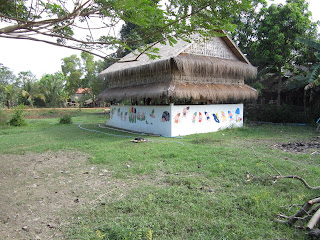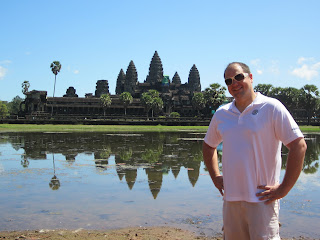Written By: Dan
To date, Cambodia has been my favorite place. And not because of the temples, weather, shopping, or food, though all are fantastic. The reason is the people. The Cambodians are the kindest people I have come across in my travels. That is amazing considering all that these people have gone through. I went in knowing nothing about the Khmer Rouge, Pol Pot, or the mass genocide these people with through. And by "these people" I don't mean this culture, ancestors, etc... I mean THESE people. The terrible things that happened in Cambodia happened in the 1970's-1990's. The Khmer Rouge genocide accounted for around 2 million deaths (about 20% of the population of Cambodia). Each person you meet in Cambodia has been directly affected by this terrible episode in history. However, through all of this, the Cambodian people are the sweetest, kindest, and most friendly people you will ever encounter. Cambodians will run up to you just to wave, smile, and bow. And if you respond likewise, they light up with the most genuine smile you will ever see. These are some of the most amazing people I have been privileged to meet.
The first trip we took in Siem Reap was by long boat to Kbal Taol. Kbal Taol is a village built in on stilts above the water of Tonle Sap Lake. No streets, sidewalks, cars, land, etc... just boats and stilt houses. In Cambodia most houses are built on stilts. Flooding isn't a disaster here, it is a way of life. Kbal Taol takes it to another level they live their lives above the water.
During the trip Children and families would come out of their houses to wave as we drove by. They seem as interested in seeing us as us seeing them. We stopped for a drink at a house with a small wood deck, then boarded a smaller boat, a flat canoe. We sat Indian-style as two young girls paddled us outside of town to see the sunset.
our boat ride into the sunset
Our second excursion was an ATV tour around the city.
A great way to see how people of Cambodia live. Unfortunately, the way most people live is poor. The majority of people in Cambodia live on less than 50 cents per day. College educated "upper class" hope to make $100-$125 per month. An ATV tour of the city did show this unfortunate side of Cambodia. Though, like I mentioned before, this does not keep the people down. As I rode through the town people came running to the street to wave as we drove by. After one stop we purchased small candies to hand out to the children. The children would literally squeal with excitement.
Stacy handing candies out to the children
One stop on our ATV ride was to
Chres School and Orphanage. Our tour guide was a very sweet 10 year old girl. We soon found out she wasn't a student, she was a teacher! It then dawned on us there were no adults here. We later found two 20-somethings teaching classes. But in all reality, this schools was run by the "older" children. Our guide took us to her classroom. Her children, ages 5-9 all stood and said "Welcome to our school. Where are you from?" Though I do not think they understood our response I was impressed with what they had learned. I was even more impressed with the teacher.
We spend around half an hour touring the school, dorms, kitchen, and library. We donated as much money as we had at the time (not enough), and went on our way.
The class room teacher (in front), and her class.
classroom where English is taught.
Building where they teach the youngest children. Notice no power or lights in any classrooms.
We left feeling bad about how the children were living at the School. The school had no lights, beds, or even power (except one room). However, on second thought we realized that the school was doing a lot of good for these kids. All the kids had food, clothes, and shelter. Many of the people we saw during our ATV ride did not. I want to help these kids out more than I did. I wish I had more money on me during my visit.
I wish I would have known what I was in for during during my trip to the floating village, orphanage, and Siem Reap villages. I realized Cambodia was a developing nation. For some reason I couldn't understand a "developing nation" means many people don't have the necessities we take for granted. I passed by countless children without clothes, houses with out running water, and families without enough to eat. And still these people are happy, warm, and inviting. Then entire time I was in Cambodia they never asked me for money. They never even asked for the candy I was giving out. They just wanted to wave, smile, and have a brief interaction with someone different. Part of me still does not understand how these people can do it.
After our trip to the village, and ATV rides we needed a more traditional tourist experience. We did what 99% of the tourists to Siem Reap do, we went to Angkor Wat. Angkor Wat is one of many temples in the area built in the 12th century. They are large, expansive complexes, that were once used as Buddhist temples, places of worship, and the political capital.
Me at Angkor Wat.
While Angkor Wat is the largest and most known, there are many temples in the area. We also toured Angkor Thom and Ta Prohm Temple (also known as the "Angelina" Temple). The Angelina Temple is not the official name, but it is known as such because Tomb Raider was filmed there. Also, Angelina Jolie adopted a Cambodian (Madux). She is quite popular around town.
Angkor Thom
Ta Prohm Temple (Angelina Temple)
We ended our trip by touring a local market, and taking a cooking class at the Hotel. Cambodian food is fantastic. Looking back, Cambodia is without a doubt one my favorite places. If there is a place with better people, food, and sites I have not experienced it. If you have the change to get to this side of the world you must go to Cambodia.



















































